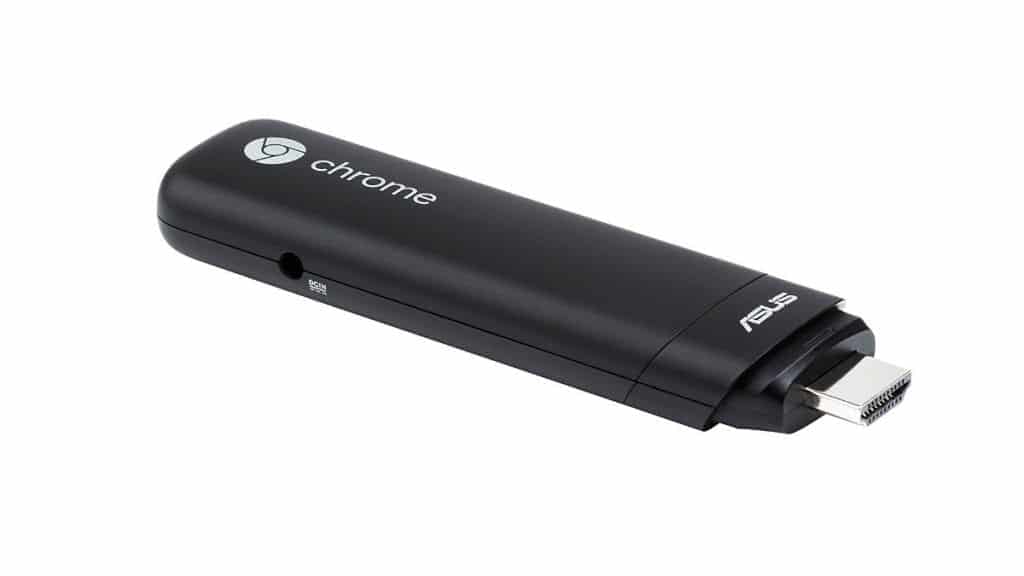The Asus Chromebit CS10 redefines the functionality of a typical Chromebox, like our Editors’ Choice Asus Chromebox M004U, and shrinks it down to the size of a USB flash drive. You can conveniently plug it into a free HDMI port on your HDTV or monitor, and you can instantly access everything on the Web, like video streaming services, cloud-based apps, among other Web services that usually lack corresponding apps on mobile devices like phones and tablets.
The Chromebit is easy to set and use, in fact its more or less the same way you plug a USB flash drive into your computer, and it offers the simplest way to enjoy cloud and streaming services on virtually any large-screen display affordably.
Design
Most of our everyday computing activities, like reading news stories, watching videos, and working online, takes place in a browser. Chrome OS-based systems like Chromebook laptops and Chromebox desktops are designed to deliver exactly that–easy access to Internet services. The Chromebit CS10 adopts that concept; ad shrinks it down to an even smaller package. The devices has the same looks of a slightly larger, rounder USB flash drive, safe for an HDMI plug on the end (instead of a USB Type-A connector).
Measuring 0.67 by 1.2 by 4.8 inches (HWD) and weighing a paltry 2.7 ounces, the Chromebit is designed to vanish behind almost any HDTV. For those who to tot a PC around in their travels, it is a cinch to take on the road, and plug into the HDTV in your office conference room, a friend’s house, or even a hotel room. Its convenience matches that of the similarly sized Intel Compute Stick, as it can be stashed into your daily commute bag, so you can carry it everywhere you go.

Connectivity
Connectivity to the Internet comes in way of dual-band 802.11ac WiFi and Bluetooth 4.0, with built-in support at the setup screen to pair Bluetooth peripherals like keyboards and mice. Its ability to handle web-authenticated Wi-Fi networks is superb, as I was able to log into my finicky guest WiFi network easily, something that is often a hurdle on other devices. That’s quite promising if you intend to use it while staying at different hotel rooms or a friend’s house. There’s no cooling fan needed for the CPU, so the Chromebit is silent in operation.
Performance
Inside is a quad-core ARM-based Rockchip RK3288 processor, 2GB of RAM, and 16GB of eMMC storage. Outside is a single USB 2.0 port capable of supporting USB hubs. If you want to use the single USB 2.0 Tupe A port, you must use a combo setup (like the Logitech Wireless Combo MK270 with Keyboard and Mouse) or a hub. Otherwise, you’ll hav to do with a Bluetooth setup. Initially, when testing I encountered sme latency when testing a Sabrent 4-Port USB 2.0 Hub with my mouse, but it cleared up after removing the hub and plugging it back in.
To test its endurance, I kept up to eight websites active in tabs and it didn’t seem to slow performance too much, even when some of the sites were streaming 1080p HD videos. However, when I attempted to stream some 4K videos from YouTube, the Chromebit’s 1.8 GHz Rockchip RK3288 processor and 2GB of memory was overwhelmed; they started to stutter after a few seconds of playback. Apparently, 4K videos are a bit taxing on memory, but other videos at 1440p, 1080p, and 720p HD resolution played smoothly.
Unlike its direct competitor –Intel’s Compute Stick – or even other Chrome OS units, the Chromebit is an easier sell to a wider variety of people. While it may not be the ultimate replacement for your streaming box or Windows PC, it suffices as a nice complement for the overall ecosystem of gadgets you may already own. And for the times when you need convenience and flexibility than a Chromecast for streaming, a dependable, basic, versatile and affordable device for daily web-based tasks comes handy. Also, when you want to have both while travelling at a price less what an Intel Compute Stick costs, the Chromebit is ideal and you won’t notice nearly as much as compromise in performance.
While a Chromebit can function like a typical Web-based PC, it isn’t possible to run our traditional Windows-based benchmark tests. Just like the Chromeboxes we’ve reviewed previously, it is simple to get a sense of how the system will react in day-to-day situations. In our anecdotal tests, the Chromebit CS10 booted up in only a few seconds, and was ready to go before I would settle in the couch. My five homepage tabs loaded fast enough, just as fast as they often do on my Mac and Windows PC on the same home broadband connection.
The Bottom Line
The Asus Chromebit can be a flexible and versatile media-streaming device if you mostly consume your music and video content from within a browser. And unlike most media streaming devices, the Chromebit functions as a PC, giving you access to your files and numerous cloud-based services. The price is right to be an impulse buy, and it’s certainly inexpensive than competing machines like the Intel Compute Stick, though the latter does have a microSD slot and runs a full Windows OS.
That said, the Asus Chromebox M004U remains our Editors’ Choice for Chromeboxes, thanks to its advanced feature set and connectivity, but admittedly, costs slightly more than the Chromebit. If all you want is to spice up your gadget ecosystem or turn a spare monitor or HDTV into an instant-on all-in-one PC, then the Asus Chromebit CS10 is worthy a long look as an easy and very inexpensive option.
